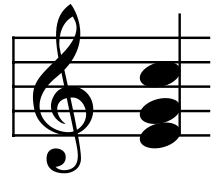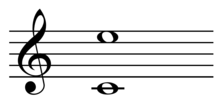- Third (chord)
-
In music, the third factor of a chord is the note or pitch two scale degrees above the root or tonal center. When the third is the bass note, or lowest note, of the expressed triad, the chord is in first inversion
 Play (help·info).
Play (help·info).Conventionally, the third is third in importance to the root and fifth, with first inversion being the second strongest inversion and the third in all primary triads (I, IV, V and i, iv, v) being variable, major or minor. In jazz chords and theory, the third is required due to it determining chord quality.
The third in both major and augmented chords is major (E♮ in C) and the third in both minor and diminished chords is minor (E♭ in C).
 Two added chords with mixed thirds, thirds separated by octave.
Two added chords with mixed thirds, thirds separated by octave.
 Play chord on left (help·info)[1]
Play chord on left (help·info)[1]  Play chord on right (help·info)
Play chord on right (help·info)Tenth
In music and music theory, a tenth is the note ten scale degrees from the root of a chord and also the interval between the root and the tenth.
Since there are only seven degrees in a diatonic scale the tenth degree is the same as the mediant and the interval of a tenth is a compound third.
Sources
- ^ Kostka & Payne (1995). Tonal Harmony, p.494. Third Edition. ISBN 0070358745.
Intervals (list) Numbers in brackets are the number of semitones in the interval.
Fractional semitones are approximate.Twelve-semitone
(Western)PerfectMajorMinorAugmentedDiminishedCompoundOther systems SupermajorNeutralSubminor7-limitchromatic semitone (⅔) · diatonic semitone (1⅙) · whole tone (2⅓) · subminor third (2⅔) · supermajor third (4⅓) · harmonic (subminor) seventh (9⅔)Other intervals GroupsPythagorean comma · Pythagorean apotome · Pythagorean limma · Diesis · Septimal diesis · Septimal comma · Syntonic comma · Schisma · Diaschisma · Major limma · Ragisma · Breedsma · Kleisma · Septimal kleisma · Septimal semicomma · Orwell comma · Semicomma · Septimal sixth-tone · Septimal quarter tone · Septimal third-tone
MeasurementOthersCategories:- Chord factors
Wikimedia Foundation. 2010.




